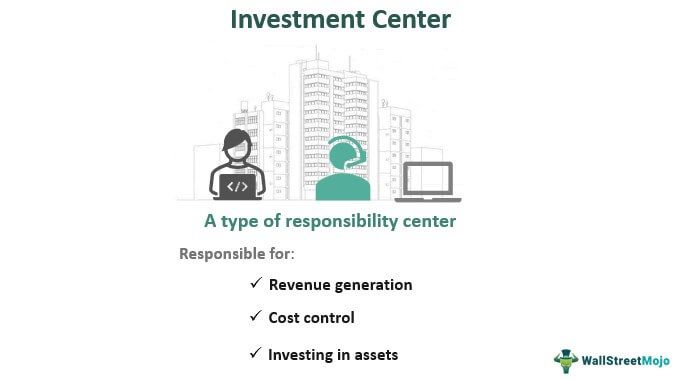Table Of Contents
Investment Center Definition
An investment center refers to an organizational unit where the manager is responsible for expenses, revenue, and investments. The parent company has delegated adequate authority to the manager or the head of the unit to decide, implement and manage the unit’s operation.

It is a type of responsibility center like profit and cost centers of a company. They focus on investing in assets that help grow the unit and contribute to the parent company's profitability. The yield on invested capital is used to assess the performance of an investment division.
Key Takeaways
- An investment center is a part of a company usually acting as a distinct entity responsible for investing in assets, controlling cost, and generating revenues.
- The managers or head of the investment division has to generate profit proportional to the investments done by the division.
- The performance of the investment division is measured in terms of the profit generated from the investment in assets using metrics like return on investment (ROI) and residual income (RI).
- It is different from profit centers that are not concerned about investment decisions.
Investment Center Explained
An investment center is an inherent part of large corporations. Companies have different units with different functionalities. For instance, HR departments manage the employees, and accounting departments deal with company accounts; both departments incur an adequate cost for functioning without creating any revenue, therefore exemplifying cost centers. The sales and production departments are profit centers since they are responsible for revenue generation. The investment division has the flexibility to make investments to generate returns to improve the profitability of their division.
The process of segregating and categorizing different units of an organization into responsibility centers predominantly serves to analyze a department's performance in terms of how well they have used the resources available to them. The management cannot use the same performance measures for gauging the advancements of different units. For instance, for cost centers, the measurement will be based on the cost incurred for a certain output, whereas for investment division, they need to access the return on investments.
The investment divisions may have diverse objectives. However, the major focus will be on revenue generation, cost control, and investing in assets. Other objectives include:
- Effective delegation of duties
- Contribute to growth of parent organization
- Motivate and empower managers
- Quick implementation of decisions
Investment divisions are significant in decentralized organizations for efficient and effective functioning. It represents a form of a small company. Sometimes they have their financial statements, specifically income statements and balance sheets. The financial statement disclosing the net income of the investment division eases the Return on investment (ROI) calculations. The profit margin formula is used to derive ROI values; the product of profit margin and asset turnover gives the return on assets.
Investment Center Example
Investment divisions are relevant in a growing business scenario. Most companies ease the operation by having different types of investment divisions. Let us consider the investment center examples of having subsidiary entities as investment divisions.
Starbucks Corporation is the American company with the largest coffeehouse chain globally. They engaged in vertical and horizontal integration strategies while gaining new markets and customers. As a result, they now have many divisions and subsidiaries acting as distinct entities. Examples of subsidiaries of Starbucks Corporations are Corporacion Starbucks Farmer Support Center Columbia, Starbucks Manufacturing Corporation, and Starbucks Capital Asset Leasing Company, LLC. For the parent company, these subsidiaries are investment divisions.
Let's consider another example of ABC Inc., MNC engaged primarily in the apparel and sports equipment business. They have retail stores across the globe. For the ease of doing business and enabling quick investment decisions which align with the host country's environment, its entire retail stores in a country will come under the ruling of the investment division functioning in that country.
Advantages & Disadvantages
Following are some of the advantages of having investment divisions:
- It helps organizations identify profit-maximizing products or revenue streams.
- It helps ascertain whether some of the business's resources may potentially become too costly for the firm or not.
- Focus on maintaining the optimal levels of inventory and receivables.
- Eases the process of expansion.
Following are some of the disadvantages:
- Funding the initiation of such centers/divisions may be especially difficult for smaller firms or startups.
- If investing in alternative financial vehicles, then the investment can be susceptible to market volatility.
Investment Center vs Profit Center
The investment and profit center differ from each other. For example, making investments and enhancing the profit proportional to the investment done is a major concern for the investment division manager, unlike the profit center manager responsible for making the projected profit.
| Parameters | Investment Center | Profit Center |
|---|---|---|
| Manager responsibility | Investment, cost, and revenue | Cost and revenue |
| Performance measures | Return on investment (ROI), residual income (RI) | Actual profit compared to a budgeted profit |
The profit center manager has to decide on input mix, product mix, selling prices, and output quantities. At the same time, the investment center manager has the power to determine capital investment requirements along with input mix, product mix, selling price, output quantities to boost productivity.
